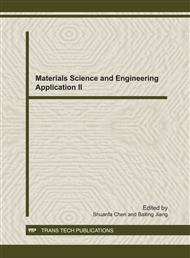p.241
p.246
p.252
p.258
p.262
p.270
p.277
p.283
p.289
Development in Wear Resistance of Fe-0.7Cr-0.8Mn Milling Balls through In Situ Reinforcing with Low Weight Percent TiC
Abstract:
In order to increase wear resistance of Fe-0.7Cr-0.8Mn cold work tool steels, low weight percentage of Ti incorporated to the alloy and subsequently, because of high affinity between additive titanium and carbon content in this alloy, low weight percentage of TiC in situ formed in matrix. These composites can be used as the milling balls in mining and cement industries because of their improved wear resistance. Formation, shape, size and distribution of TiC particles within the matrix were studied by optical microscopy equipped with image analyzer, optical emission spectroscopy, scanning electron microscopy and energy dispersive spectroscopy. Also microhardness and density of the samples measured. Abrasion wear tests were carried out using a pin on disc type machine. An experimental design based on Taguchi method was applied to investigate the effect of TiC content, applied load, sliding distance and roughness of SiC abrasive paper on wear behavior of samples. The results show that by reinforcing the Fe-0.7Cr-0.8Mn steels with low weight percentage of TiC, wear resistance of these kind of milling balls significantly increases. Sliding distance has the most influence on wear rate of samples, also weight loss of samples decreases as sliding distance, applied load and roughness of grinding decreases.
Info:
Periodical:
Pages:
262-269
Citation:
Online since:
December 2011
Keywords:
Price:
Сopyright:
© 2012 Trans Tech Publications Ltd. All Rights Reserved
Share:
Citation:


